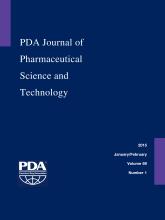Research ArticleTechnology/Application
Implementation of a High-Throughput Ion Chromatographic Assay To Assess Glass Degradation in Drug Product Formulations
Renuka Thirumangalathu, Kwun Ngok Wong, James Coultas, Alison Hair and Deirdre Murphy Piedmonte
PDA Journal of Pharmaceutical Science and Technology January 2015, 69 (1) 96-107; DOI: https://doi.org/10.5731/pdajpst.2015.01007
Renuka Thirumangalathu
‡Drug Product Development, Process and Product Development, Amgen Inc., Thousand Oaks, CA; and
Kwun Ngok Wong
‡Drug Product Development, Process and Product Development, Amgen Inc., Thousand Oaks, CA; and
§Current address: University of Southern California, Los Angeles, CA 90089
James Coultas
‡Drug Product Development, Process and Product Development, Amgen Inc., Thousand Oaks, CA; and
Alison Hair
‡Drug Product Development, Process and Product Development, Amgen Inc., Thousand Oaks, CA; and
Deirdre Murphy Piedmonte
‡Drug Product Development, Process and Product Development, Amgen Inc., Thousand Oaks, CA; and

References
- 1.↵
- 2.↵
- Wirth G. S.,
- Gieskes J. M.
- 3.↵
- Bohrer D.,
- Do Nascimento P. C.,
- Becker E.,
- Bortoluzzi F. D.,
- De Carvalho L. M.
- 4.↵
- Conradt R.
- 5.↵
- Bunker B. C.
- 6.↵
- Baillif P.,
- Chouikhi B.,
- Touray J. C.
- 7.↵
- 8.↵
- Iler R. K.
- 9.↵
- Dietzel M.
- 10.↵
- Dove P. M.,
- Han N.,
- Wallace A. F.,
- De Yoreo J. J.
- 11.↵
- Iacocca R. G.,
- Allgeier M.
- 12.↵
- Ledieu A.,
- Devreux F.,
- Barboux P.,
- Sicard L.,
- Spalla O.
- 13.↵
- Borchert S. J.,
- Ryan M. M.,
- Davison R. L.,
- Speed W.
- 14.↵
- Abernethy S.,
- Dowd N.,
- Bochert S.,
- Butler D. A.,
- Clayton R.,
- Eckhart C.,
- et al
- 15.↵
USP. Evaluation of the Inner Surface Durability of Glass Containers Posted for Comment, 2012. http://www.usp.org/usp-nf/notices/evaluation-inner-surface-durability-glass-containers-posted-comment.
- 16.↵
- 17.↵
- Ratnaswamy G.,
- Hair A.,
- Li G.,
- Thirumangalathu R.,
- Nashed-Samuel Y.,
- Brych L.,
- Dharmavaram V.,
- Wen Z.,
- Fujimori K.,
- Jing W.,
- Sethuraman A.,
- Swift R.,
- Ricci M. S.,
- Piedmonte D. M.
- 18.↵
- Perera G.,
- Doremus R.
- 19.↵
- Cox B.
- 20.↵
Two ways to minimize the delamination risk of glass containers. Schott Pharmaceutical Packaging Newsflash 2012, 17.
- 21.↵
- Bohrer D.,
- Bortoluzzi F.,
- Nascimento P. C.,
- Carvalho L. M.,
- Ramirez A. G.
- 22.↵
- Guadagnino E.,
- Zuccato D.
- 23.↵
- Schwartz M.
- 24.↵
Determination of Silicate in High Purity Water Using Ion Chromatography and AutoPrep. Dionex Application Note 170. Dionex Corporation/ThermoScientific (Sunnyvale CA), 2014. [Online]. http://www.dionex.com/en-us/webdocs/62945-AN170-IC-Silicate-UHPW-AN70946_E.pdf. (accessed 12/1/2014).
- 25.↵
Determination of Dissolved Silica and Common Anions Using Dual Detection. Dionex Application Update 113. Dionex Corporation/ThermoScientific (Sunnyvale, CA), 2009. [Online]. www.dionex.com/en-us/webdocs/4072-AN113_LPN0736.pdf. (accessed 12/1/2014).
- 26.↵
- 27.↵
- Tarutani T.
- 28.↵
- Govett G. J. S.
- 29.↵
- Vial J.,
- Jardy A.
- 30.↵
In This Issue
PDA Journal of Pharmaceutical Science and Technology
Vol. 69, Issue 1
January/February 2015
Implementation of a High-Throughput Ion Chromatographic Assay To Assess Glass Degradation in Drug Product Formulations
Renuka Thirumangalathu, Kwun Ngok Wong, James Coultas, Alison Hair, Deirdre Murphy Piedmonte
PDA Journal of Pharmaceutical Science and Technology Jan 2015, 69 (1) 96-107; DOI: 10.5731/pdajpst.2015.01007
Implementation of a High-Throughput Ion Chromatographic Assay To Assess Glass Degradation in Drug Product Formulations
Renuka Thirumangalathu, Kwun Ngok Wong, James Coultas, Alison Hair, Deirdre Murphy Piedmonte
PDA Journal of Pharmaceutical Science and Technology Jan 2015, 69 (1) 96-107; DOI: 10.5731/pdajpst.2015.01007
Jump to section
Related Articles
- No related articles found.
Cited By...
- No citing articles found.





